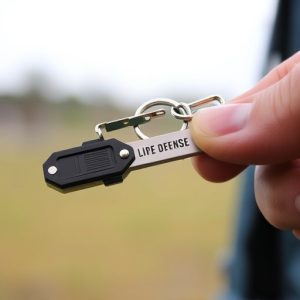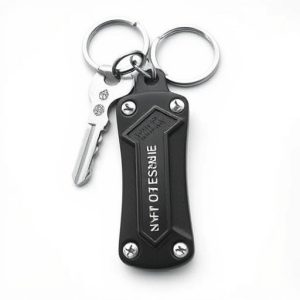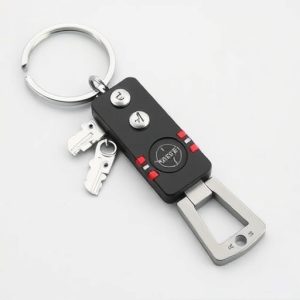Keychain Safety Devices: Legal, Material, & Design Requirements Check
The legal landscape for keychain safety devices varies globally, focusing on material durability and…….
The legal landscape for keychain safety devices varies globally, focusing on material durability and non-lethal design to protect the public. When selecting a keychain defense tool, prioritize high-strength materials like steel or advanced polymers, ensuring longevity and superior grip. Keychain weapon designers must meet safety standards by using durable metals like stainless steel to prevent rust and maintain structural integrity. The market's growing demand for personal safety has led to innovative designs with robust materials, powerful springs, and sharp blades, appealing to consumers seeking reliable, long-lasting self-defense options. Strict consumer protection laws mandate the use of high-quality, durable materials to safeguard users from defective products, encouraging manufacturers to prioritize quality over cost.
“Ensuring keychain safety devices meet legal requirements is paramount for personal defense enthusiasts. This comprehensive guide explores the intricate balance between innovation and regulation in the market for keychain self-defense tools. From understanding global legal frameworks governing these compact weapons to examining durable materials that bolster longevity and safety, this article covers crucial aspects. Discover how design features align with regulatory standards and delve into emerging trends shaping the industry, while navigating consumer protection and product liability considerations.”
- Understanding Legal Frameworks for Keychain Safety Devices
- Materials Considerations for Longevity and Safety
- Design Features to Meet Regulatory Standards
- Market Trends in Keychain Self-Defense Tools
- Consumer Protection and Product Liability Aspects
Understanding Legal Frameworks for Keychain Safety Devices
In many regions, the legal landscape surrounding keychain safety devices is a complex web of federal and local regulations. Understanding these frameworks is crucial for consumers and manufacturers alike to ensure compliance and promote public safety. The primary focus often lies on materials used in construction, with an emphasis on durable and non-lethal options. Laws typically dictate that such devices must be designed with safety mechanisms to prevent accidental deployment and minimize injury risk.
For instance, regulations may specify maximum force requirements for activation triggers, mandating that keychain weapons cannot easily be discharged without clear intent. Additionally, materials like high-quality metals and impact-resistant plastics are often preferred due to their durability. These legal stipulations not only safeguard users from potential harm but also ensure that such devices serve as reliable personal safety tools when used appropriately.
Materials Considerations for Longevity and Safety
When designing or selecting a keychain safety device, it’s crucial to consider materials that ensure both longevity and safety. Opting for durable materials is essential to guarantee the device can withstand regular use and potentially stressful situations. Materials like high-strength steel, titanium, or advanced composite polymers are ideal choices as they offer exceptional resistance to wear and tear, making them suitable for everyday carry tools.
Additionally, these sturdy materials contribute to enhanced safety features. They provide better grip and durability, reducing the risk of accidental drops or slippage. Moreover, certain durable materials are resistant to corrosion, ensuring the keychain’s functionality over an extended period. This is particularly important for those living in humid environments or frequently exposing their keychains to water or moisture.
Design Features to Meet Regulatory Standards
When designing a keychain safety device, it’s paramount to incorporate robust features that align with legal and regulatory standards. One key aspect is utilizing durable materials for the keychain weapon component. Metals like stainless steel or high-grade alloys are ideal choices due to their resistance to rust and ability to withstand frequent use without compromising integrity. These materials ensure the device remains reliable and safe over time, fulfilling legal requirements for product durability.
Additionally, the design should focus on safety mechanisms that prevent accidental activation. This includes secure locks or safeguards that can only be triggered by authorized users, addressing potential legal concerns related to misuse. Such considerations are essential to pass regulatory checks and provide users with a secure and legally compliant self-defense option.
Market Trends in Keychain Self-Defense Tools
The market for keychain self-defense tools has seen a significant rise in recent years, reflecting an increasing demand for personal safety and convenience. Consumers are seeking compact, easily portable solutions for self-defense, leading to innovative designs and the integration of various safety features into these tiny devices. One notable trend is the emphasis on using durable materials; high-quality metals like stainless steel and robust plastics ensure that these keychains can withstand regular use and harsh conditions without compromising their effectiveness.
This shift towards durability aligns with a broader consumer preference for long-lasting, reliable products, especially in safety-focused items. Manufacturers are responding by offering keychains equipped with advanced mechanisms, such as powerful springs and sharp blades hidden within the compact frame, ensuring users have access to self-defense tools without drawing unnecessary attention. The integration of these durable materials not only enhances the physical durability of the keychains but also contributes to their overall reliability in critical situations.
Consumer Protection and Product Liability Aspects
When it comes to consumer protection and product liability, keychain safety devices must meet stringent legal requirements to ensure user safety. One critical aspect is the use of durable materials for the construction of these keychains, especially if they are designed as self-defense weapons. Manufacturers must adhere to guidelines that guarantee the materials’ strength and longevity, preventing sudden failures or malfunctions that could lead to injuries.
Product liability laws hold manufacturers accountable for any harm caused by their products. Therefore, using high-quality durable materials is essential in designing keychain safety devices. This ensures that consumers are protected against potential risks associated with product defects, encouraging manufacturers to prioritize quality and safety over cost-cutting measures.
When considering a keychain safety device, it’s crucial to navigate a blend of legal requirements, material choices, design features, and market trends. Ensuring your chosen device meets regulatory standards for self-defense tools is paramount, especially when prioritizing consumer protection and product liability. Opting for durable materials like high-quality metal or robust plastic can significantly enhance longevity and safety. Remember that staying informed about market innovations and legal updates ensures you make a responsible and legally compliant decision.


